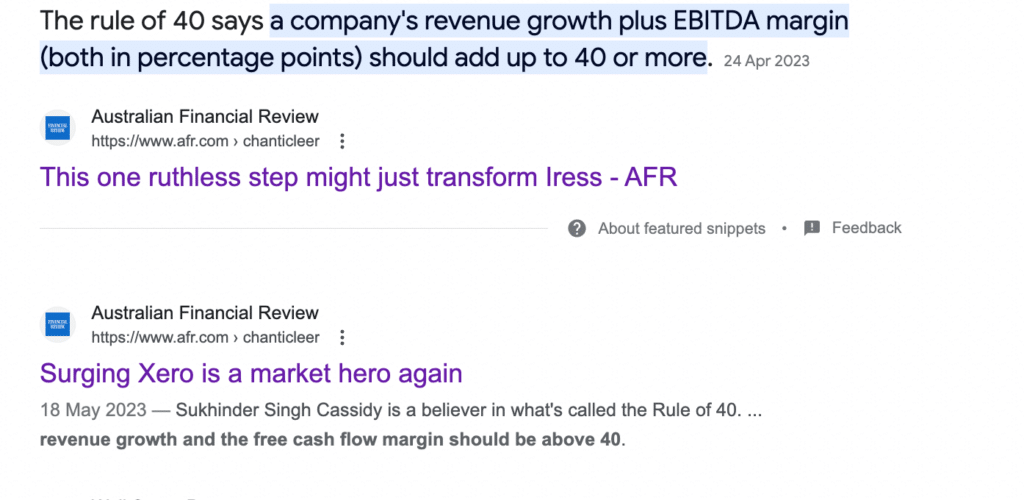One common question for investors is; “What is The Rule Of 40?” While the Rule of 40 is always measuring a proxy of owner earnings and growth, the exact measures used to calculate the rule of 40 can vary between analysts. The key question is whether you should use free cash flow for the rule of 40 or if you should use EBITDA for calculating the rule of 40. This article will look at the two main ways to calculate the rule of 40.
According to McKinsey, the rule of 40 is calculated by adding the free cash flow margin and the revenue growth rate. The free cash flow margin is generally calculated as free cash flow divided by revenue, while the revenue growth rate is the amount the revenue increased over the last year. I have already written an article about how to calculate free cash flow from primary documents.
According to Bain, the rule of 40 is calculated by adding the EBITDA margin and the revenue growth rate. Bain claims that EBITDA “excludes the effect of taxes and accounting policies” but this is false, since accounting policies around the capitalisation of software development certainly impact EBITDA. For example, if a company has high and growing capitalisation of investment in software development, then its EBITDA will be much higher than its free cash flow.
The main thing is to be consistent about how you calculate the rule of 40 between companies. For this reason, I would caution against using unaudited numbers like underlying or adjusted EBITDA, because different companies might be making substantially different adjustments to their EBITDA. Equally, if you use EBITDA to compare two companies with different accounting policies when it comes to the capitalisation of software development, then you will favour the one that capitalises more software development.
Many news outlets do not use a consistent definition of the Rule of 40. For example, you can see below that the Australian Financial Review published two seperate definitions in two seperate articles.

How To Calculate The Rule Of 40
Using the FY 2023 Xero results, I’ll calculate the rule of 40 in a variety of ways.
First, let’s use the company’s normalised free cash flow, since this is the way Xero will be measuring itself.
Xero FY 2023 Revenue ~$1.4b
Xero FY 2023 annual revenue growth 28%
Xero Free Cash Flow (per the company’s definition) $102.3m
Xero Free Cash Flow margin is $102.3 million divided by $1.4b, or about 7.3%
Rule of 40 calculated by adding 7.3% + 28% to reach 33.5%, falling short of the rule of 40.
Next, let’s use the EBITDA definition to calculate the rule of 40.
Xero statutory EBITDA $158.2m
Xero statutory EBITDA margin is $158.2m million divided by $1.4b, or about 10.8%.
Rule of 40 calculated by adding 10.8% + 28% to reach 38.8%, much closer to the rule of 40.
Finally, let’s calculate the rule of 40 using a strict (not normalised) definition of free cash flow, since this is easiest to standardise across companies.
For Xero, a strict definition of free cash flow would be operating cash flow ($390.5m) minus all investing cash outflow ($304.9m) minus repayment of leases ($16.5m) which equals $69.1m.
Therefore the strict free cash flow margin would be 4.9%.
So to calculate the rule of 40 you would add 4.9% to 28% to get 32.9%.
While this is the harshest definition (giving the lowest score), I prefer it since using the statutory cash flow numbers gives a good basis to compare different companies carefully.
Is The Rule Of 40 Be Calculated With Free Cash Flow or EBITDA?
Should salmon roe be called caviar? It can be.
Is almond milk really milk? Some people think so.
There is simply no right answer regarding whether the Rule of 40 should be calculated with free cash flow or EBITDA. Some require the use of free cash flow, which actually measures the amount of money accumulating in the company’s bank account, while others lap up the non-cash paper profit proxy EBITDA with enthusiastic abandon.
Investors should remember that Charlie Munger said, “Every time you hear ‘EBITDA,’ just substitute the phrase ‘bullshit earnings.” Personally, whenever I think about the Rule of 40 calculated with EBITDA instead of free cash flow, I substitute the phrase “bullshit Rule Of 40”, as it helps me better contextualise the quality of the analysis.
Sign Up To Our Free Newsletter